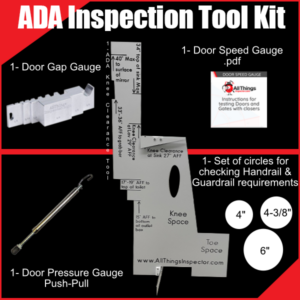
Ensuring ADA compliance for public accommodations is vital in fostering an inclusive society. From retail stores to concert venues, businesses must prioritize accessibility to uphold justice in commerce. Understanding the nuances of ADA inspections not only protects enterprises from potential liabilities but also welcomes a broader audience. Making your business accessible is not just a legal obligation; it’s a commitment to every customer. Keep reading to discover effective strategies that can transform your establishment into a welcoming space for all.
When I think about the implications of ADA compliance for public accommodations, several key aspects come to mind. First, understanding what constitutes a public accommodation under the law is pivotal, as these establishments must adhere to regulations set forth by the United States Department of Justice ada inspections. This law serves not only to protect the rights of individuals with disabilities but also highlights the importance for business owners to prioritize accessibility. Moreover, grasping the key principles of accessible design can empower businesses to create an inclusive environment that accommodates everyone, regardless of physical limitations or specific diseases. Ensuring compliance isn’t just about following legal requirements; it also reflects a commitment to serving all members of the community.
In my exploration of ADA compliance, I’ve learned that public accommodations encompass a wide array of entities, including hotels and lodging facilities. These establishments, along with corporations that operate services like amusement parks and transportation options such as vehicle rentals, must adhere to accessibility standards. Living near the Great Lakes, I’ve come to appreciate how local attractions also play a vital role in ensuring that everyone, regardless of ability, feels welcome and can enjoy their experiences fully.
As I navigate the landscape of business ownership, I recognize that ADA compliance is not just a legal obligation but a moral imperative. The Rehabilitation Act of 1973 set the foundation for preventing discrimination against individuals with disabilities, and ignoring this can lead to serious repercussions for those businesses that might overlook accessibility. For instance, having accessible sidewalks ensures that everyone can approach my establishment comfortably, illustrating how small modifications can foster a more inclusive community and potentially expand our customer base.
Attending lectures on disability rights has opened my eyes to the economic advantages of being ADA compliant. In today’s competitive market, businesses that provide equitable service not only uphold the law, but also enhance their reputation, which can lead to more favorable health insurance options and lower liabilities. Ultimately, prioritizing accessibility is a proactive approach that benefits both the community and my bottom line.
As I delve into the key principles of accessible design, I recognize that adherence to building codes is paramount for creating welcoming spaces. These codes often provide specific guidelines that ensure accessibility features, such as ramps for mobility aids and designated pathways, are integrated into construction projects. By following these standards, not only do we comply with legal expectations set forth by the Equal Employment Opportunity Commission, but we also foster an environment where everyone, regardless of their physical abilities, feels accommodated and valued.
As I consider Title III of the Americans with Disabilities Act, it becomes clear how this section specifically addresses the services essential for public access. Various entities, from healthcare providers to large venues like convention centers, fall under its scope, ensuring that they provide equal access to all patients. While this expansive coverage aims to protect civil rights, there are also exemptions that business owners need to navigate, which can lead to confusion regarding compliance obligations. Additionally, new businesses must adhere to specific requirements laid out by Title III to create accessible environments from the outset. Understanding these aspects not only helps in aligning with legal standards but also reinforces a commitment to inclusivity and respect within the community, whether as a landlord or an operator of a public space.
When I consider the services covered under Title III, I note that it encompasses a range of public accommodations, including restaurants, retail establishments, and recreational facilities. These entities must ensure that people with disabilities can navigate their spaces freely, which includes pivotal elements like accessible entrances and restrooms. By fulfilling these obligations, business owners not only uphold the rights of individuals with disabilities but also safeguard their investments in lease agreements and mitigate potential tax implications related to non-compliance.
Understanding the exemptions within Title III is crucial for me as a business owner, especially when considering the implications of the undue burden standard. This standard can exempt certain facilities from making structural changes, like the installation of an elevator, if the financial cost is disproportionate to their resources. I’ve learned that engaging in mediation can be a helpful avenue for resolving accessibility disputes, particularly for establishments seeking to accommodate individuals with intellectual disabilities while still remaining within practical limits.
When I establish a new business, I must consider the specifics outlined by Title III of the Americans with Disabilities Act, especially the requirements set forth by the ADA Amendments Act of 2008. This legislation not only broadens the scope of what constitutes a disability but also emphasizes the necessity of providing features such as designated parking spaces and allowing service animals on premises. By integrating these elements, I create an inclusive environment that meets the standards of the Rehabilitation Act while ensuring that everyone can access my services without barriers.
Understanding the nuances of ADA Standards for Accessible Design is essential for anyone aiming to achieve true equity within their establishments. I’ve often found that navigating the 2010 ADA Standards can be challenging due to common misconceptions surrounding accessible design. These myths can hinder business owners from realizing their responsibilities and the benefits of compliance. Furthermore, as our society increasingly relies on technology, I recognize the growing importance of incorporating web accessibility standards to ensure equal opportunity for individuals with disabilities. As a health professional, I strive to make my services open and welcoming to everyone, which is why this paragraph is crucial for grasping the full scope of ADA compliance.
Navigating the 2010 ADA Standards for Accessible Design can present challenges, especially when considering the needs of individuals with visual impairments and the requirements for effective communication, such as sign language. In my experience, ensuring that a building not only adheres to architectural guidelines but also provides necessary accommodations can significantly impact how accessible and welcoming a space feels. When faced with accessibility complaints, engaging a knowledgeable lawyer can be invaluable in understanding and rectifying any shortcomings in compliance.
One significant misconception I’ve encountered regarding ADA design standards is the belief that compliance only applies to specific types of businesses, such as restaurants or hotels. In reality, all public accommodations, including a bowling alley, must adhere to these standards. ADA compliance extends beyond mere physical modifications; it includes provisions such as accessible computer hardware and plumbing fixtures, ensuring that every facility serves all individuals, regardless of their abilities.
Another misunderstanding involves the relationship between ADA standards and other legislation, like the Air Carrier Access Act. Many assume that ADA compliance solely covers physical spaces and does not pertain to transportation services. This is inaccurate, as both laws work together to ensure that individuals with disabilities receive equal access to facilities and services, whether they’re in an airport or boarding an aircraft.
As I dive into the realm of technology and web accessibility standards, I recognize their crucial role in achieving a fully inclusive environment. Ensuring that telecommunications services in spaces, whether an auditorium or factory, meet accessibility requirements enhances safety for all users, including those with disabilities. By addressing these standards, I can foster an atmosphere that accommodates everyone and enriches their experience within my establishment.
In my journey towards ensuring ADA compliance in my own business, I recognize the importance of implementing practical steps that pave the way for accessibility. Conducting an ADA compliance audit is a great starting point; it allows me to identify gaps and verify that I align with the code of federal regulations required for public accommodations. As I assess my establishment, prioritizing barrier removal becomes essential, particularly in spaces like a food bank or a drug rehabilitation center, where individuals may need additional support. Furthermore, I’ve found that investing in staff training on ADA compliance and accommodations not only fosters a welcoming environment, but also equips my team with the knowledge to cater to diverse needs. This comprehensive approach reinforces my commitment to serving all members of my jurisdiction while aligning with legal standards and ethical responsibilities.
To ensure my business meets the standards set by the Americans with Disabilities Act of 1990, I prioritize conducting an ADA compliance audit. This process requires my full attention, as it systematically identifies any potential barriers that could prevent individuals with disabilities from accessing my services. I find that addressing requirements such as closed captioning and other communication tools is essential in fostering an inclusive environment while reducing the risk of legal action that could end up in court.
Engaging with legal experts, such as an attorney general or ADA compliance specialists, can greatly assist me in understanding the nuances of the law and ensuring full compliance. By proactively addressing any deficiencies unearthed during the audit, I demonstrate my commitment to creating an accessible environment for all patrons. This not only upholds the principles of the ADA but also positions my business favorably in the community.
As I prioritize accessibility improvements in my business, I focus on removing barriers that hinder the ability of individuals with disabilities to access goods and services. It’s crucial to understand that failure to comply with regulations can impact not only those who wish to transport themselves to my establishment but also my reputation as a service provider. By implementing reasonable accommodations, I can create a welcoming space that enhances the overall experience for all my patrons.
Training my staff on ADA compliance and accommodations is a fundamental step in creating an inclusive environment. I focus on familiarizing them with the principles of physical therapy and how they intersect with our services, emphasizing the importance of understanding the specific needs of individuals with disabilities. Utilizing resources from the Job Accommodation Network helps me ensure that our team is aware of effective strategies to eliminate any architectural barriers outlined in the Architectural Barriers Act of 1968, thereby enhancing the overall welfare of all patrons who enter our private school or any public space we operate.
In my ongoing efforts to ensure that all customers feel valued and respected, effective communication with individuals who have disabilities is paramount. Providing auxiliary aids and services for communication enhances the experience for those who may require additional support, adhering to guidelines outlined in section 504 of the Rehabilitation Act. It’s essential to clarify our policies regarding service animals and mobility devices, as this fosters understanding and reduces confusion among patrons. Additionally, I strive to handle requests for accommodation with sensitivity and best practices in mind, as a fee may not be necessary in certain situations, especially within child care settings. Implementing these strategies not only fulfills our legal obligations but also creates a more welcoming and inclusive environment for everyone.
When I plan for auxiliary aids and services for communication in my establishment, I understand the importance of aligning with the international building code to ensure all users, including those needing assistance, can navigate spaces like bathrooms effectively. I’ve discovered that providing these aids may incur an expense, but it is a necessary investment to comply with the statute governing accessibility. This commitment not only applies to physical locations but also extends to facilities like commuter rail systems, emphasizing our responsibility to accommodate every individual in our community.
In my experience, establishing clear policies on service animals and mobility devices is crucial for ensuring an inclusive environment. I prioritize adherence to the American National Standards Institute guidelines, which provide valuable structure for integrating such supports within my establishment. Offering information in braille and ensuring that floor layouts accommodate these vital aids not only mitigates the risk of misunderstandings but also enhances the overall experience for all patrons, including those who rely on therapy animals for assistance.
When I receive requests for accommodation at my property, I ensure that the process is straightforward and efficient. I focus on assessing the specific needs mentioned by the individual, whether that involves providing resources like accessible drinking fountains or addressing barriers such as stairs that may limit access. By fostering open communication, I can better understand and fulfill these requests, ultimately enhancing the experience for everyone involved.
As I consider the necessary steps to achieve ADA compliance in new constructions and renovations, understanding the specific requirements for new facilities becomes paramount. I find that documenting all ADA requirements not only streamlines the design and construction process but also minimizes the risk of costly lawsuits in the future. For existing structures, managing alterations carefully is crucial to ensure both compliance and usability for individuals with disabilities. Additionally, I realize the significance of state and local codes in shaping our approach, as they can provide more stringent standards than federal laws. This knowledge is especially vital in fields like health care and can help prevent potential issues related to employment discrimination by ensuring that facilities are truly accessible for all.
When I think about ADA requirements for new constructions and facilities, I realize how crucial it is to design spaces that prioritize accessibility without imposing undue hardship on the business. Incorporating accessible aisles and pathways ensures that all passengers, regardless of physical limitations, can navigate comfortably, which reflects positively on the overall employment experience within the organization. Addressing FAQs about compliance during the planning phase also helps clarify any potential concerns, enabling us to create a truly inclusive environment from the start.
When managing alterations to existing structures for compliance, I focus on integrating features that support individuals with various disabilities, such as installing grab bars in restrooms and ensuring adequate signage for those with deafness. Understanding the implications of the standards set by the Federal Communications Commission is crucial in maintaining effective communication channels within my facility. As I adopt these practices, I also recognize the importance of creating welcoming recreation spaces that cater to the diverse needs of all community members.
As I consider compliance with the ADA, I realize that state and local codes play a critical role in shaping my approach. Each jurisdiction can impose more stringent requirements than those outlined federally, which I must adhere to in my nursing home and other facilities to ensure thorough accessibility. For instance, policies regarding curb access and room configurations often vary, and understanding these nuances helps maintain my business’ license by aligning with all necessary standards.
ADA compliance for public accommodations is vital for fostering inclusivity and ensuring equal access for individuals with disabilities. By understanding the requirements and implementing key accessibility features, businesses not only meet legal obligations but also enhance their reputation within the community. Prioritizing accessibility opens up opportunities for growth by attracting a diverse customer base. Ultimately, a commitment to ADA compliance reflects a genuine dedication to serving all members of society.



Measuring door pressure is acting in compliance with building regulations, like the Americans with Disabilities Act (ADA). It’s an important step in ensuring accessibility, safety

When talking about building safety, the first things that come to mind are fire alarms, emergency exits and security systems. Meanwhile, the one tool that